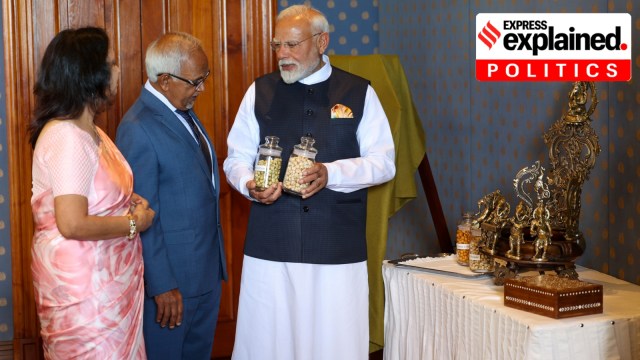The politics of makhananomics: Behind government’s push to boost Bihar’s makhana industry
Bihar is responsible for the production of 90% of India’s makhana crop. Ahead of the Assembly election, the ruling coalition has made significant efforts to grow the industry
 Prime Minister Narendra Modi presenting makhana to Mauritius President Dharambeer Gokhool at Port Louis, in Mauritius on March 11, 2025. (PIB)
Prime Minister Narendra Modi presenting makhana to Mauritius President Dharambeer Gokhool at Port Louis, in Mauritius on March 11, 2025. (PIB)Speaking at a poll rally in Samastipur, Bihar, Prime Minister Narendra Modi on Friday (October 24) referred to the recently-inaugurated National Makhana Board as a “revolution”.
The state of Bihar contributes to roughly 90% of India’s makhana (foxnut) production. In recent months, members of the ruling party, including the Prime Minister himself, have repeatedly spoken about the government’s efforts to support the makhana industry.
Ahead of the state Assembly election next month, this makhananomics is meant to serve a distinct political purpose.
A fitness fad…
Makhana is the dried edible seed of the prickly water lily or gorgon plant (Euryale ferox), a species which grows in freshwater ponds across South and East Asia. The plant is known for its violet and white flowers, and massive, round and prickly leaves — often stretching more than a meter across.
Most of the makhana grown in India comes from Bihar, where production is concentrated in the nine districts of northern and eastern Bihar — Darbhanga, Madhubani, Purnea, Katihar, Saharsa, Supoul, Araria, Kishanganj and Sitamarhi — which fall in the so-called Mithilanchal region. Of these, the first four districts mentioned contribute to 80% of Bihar’s makhana production.
 Wikimedia Commons
Wikimedia Commons
“Makhana crop is grown in almost 15,000 hectares in Bihar which produces nearly 10,000 tonnes of popped makhana,” a 2020 paper by Indian Council of Agricultural Research said.
While makhana has been consumed, often in ritual settings, for centuries, of late it has gained popularity as a “superfood” due to its nutritional benefits — experts say that makhana is nutrient-dense and low-fat, making it an ideal “healthy snack”.
This has prompted the government to make efforts to harness its commercial potential, including through concerted marketing campaigns and the creation of stronger industrial infrastructure and linkages. The establishment of the Makhana Board is a part of this push.
The global makhana market was valued at $43.56 million in 2023, and expected to touch the $100 million-mark by 2033, according to the market research firm Spherical Insights.
…But a fledgling industry
Despite being the largest producer, Bihar has not been able to harness makhana’s growing market. Indeed, the largest makhana exporters in India are Punjab and Assam; the former does not even grow its own makhana.
Bihar neither has a developed food processing industry, nor required export infrastructure. “Thus, Bihar ends up selling all its fox nuts as raw material to FPUs (food processing units) outside the state at cheap prices. These FPUs add value to the product through flavouring and packaging, and thus command better prices,” a senior bureaucrat in Bihar told The Indian Express in February.
“Additionally, since the market in Bihar is not well-developed and organised, there is a long chain of intermediaries leading to those engaged in fox nut farming getting very low prices compared to what makhana commands in the commercial market. Thus, neither the farmer, nor the state — in terms of revenue — earns what they actually can,” the bureaucrat said.
Low productivity is another major problem in makhana cultivation in Bihar. Currently, cultivating makhana is an extremely arduous and labour heavy process, which pushes up the overall input costs.
 The cultivation of makhana is an arduous process, carried out by one of Bihar’s most impoverished communities. File
The cultivation of makhana is an arduous process, carried out by one of Bihar’s most impoverished communities. File
Seeds are sown in standing water bodies and harvesting is carried out manually by diving to the bottom of the water body. Subsequent processing of makhana, from cleaning and sun drying the seeds to roasting and finally “popping”, is also all manual.
Moreover, farmers have been slow to adopt high yield varieties of fox nut seeds developed by agricultural institutes, such as Swarna Vaidehi and Sabour Makhana-1. According to the 2020 ICAR paper, traditional farming practices have a production capacity of 1.7-1.9 tonnes per hectare, far lower than the 3-3.5 tonnes per hectare from the HYV seeds.
“More awareness needs to be created among farmers to adopt better seeds,” the bureaucrat had said. He added, however, that “attempts at mechanising the harvesting process have not worked” because “the industry has not been able to come up with an efficient machine”.
Creating an ecosystem
Sources in the Bihar government said that the state needs a robust food processing industry, along with strong chains of storage facilities, an efficient market, and an export infrastructure. This is where the new Makhana Board, with an initial budget of Rs 100 crore, comes in.
It is meant to “improve production, processing, value addition, and marketing of makhana,” Union Finance Minister Nirmala Sitharaman had said in her Budget speech in February, adding, “The Board will provide hand holding and training support to makhana farmers, and will also work to ensure they receive the benefits of all relevant Government schemes”.
JDU Working President Sanjay Jha had said in February that the state government expects to create the right ecosystem for food processing units through the Makhana Board, and a food processing institute the government has announced.
“Then the airport at Patna is being expanded. Very soon the Purnea and Darbhanga airports will be fully functional. All these will have cargo holds. This will facilitate exports,” he had told The Indian Express.
A senior Bihar bureaucrat, however, urged some caution. He said that a lot will depend on how much money the governments, both the Centre and the state, are willing to spend, and how much interest they take in realising the potential of the food processing sector in Bihar.
Earlier attempts to this end have not been very encouraging. In 2002, the government set up a National Research Centre for Makhana under ICAR in Bihar. Till July last year, the Darbhanga-based centre had only 10 employees against a sanctioned strength of 42. There was no administrative staff, and a full-time director was never appointed.
Political significance
Nitish Kumar has been in power in Bihar for the past two decades (with a brief, less-than-a-year-long hiatus in 2014-15, when Jitan Ram Manjhi was chief minister). Over the years, he has faced criticism for being unable to imagine Bihar’s economic growth beyond roads and power supply.
Ahead of this year’s state Assembly polls, the makhananomics push is a part of the ruling coalition’s larger economic imagination for the state, especially at a time when unemployment and migration have emerged as key poll issues.
With some 10 lakh families in Bihar involved in the cultivation and processing of makhana, supporting the industry can benefit millions in the electorate, especially those belonging to the impoverished Mallah community.
The farming and harvesting of Makhana is almost entirely done by the Mallahs. Although accounting for only 2.6% of Bihar’s population, Mallahs are concentrated in the riverine belts of North Bihar, where they can command a voteshare of more than 6%.
The community has historically sided with social justice parties since the JP movement. In recent years, however, they have been wooed by all parties in successive elections given that they are also an assertive caste who can get other lower castes to rally behind them.
In a closely fought election, the NDA would want them on its side. “It will not only give much needed impetus to the makhana industry in Bihar, but also help its farmers who come from the impoverished community of fishermen. Since it is a labour-intensive industry, it will also create jobs for the community,” Jha had told The Indian Express.
Last year, the Bihar government had asked for an MSP for makhana from the Centre. In 2022, ‘Mithila Makhana’ was conferred a Geographical Indication (GI) tag, a certification that signifies that a product can only be grown in a particular geographical location, and as a result, has unique characteristics (like Darjeeling’s tea or Mysore sandal soap).
This is an updated version of an article first published in February this year.





- 01
- 02
- 03
- 04
- 05

































